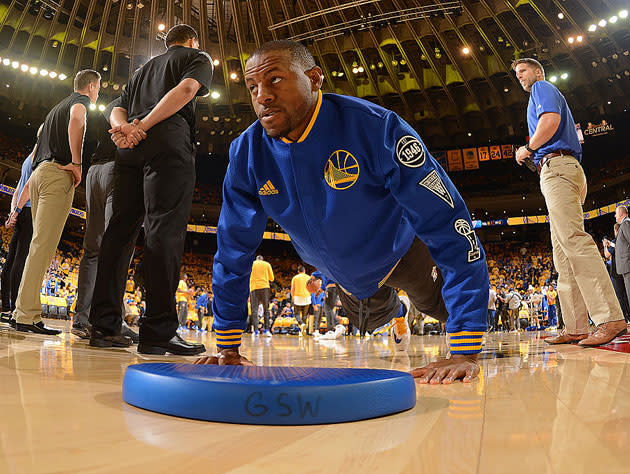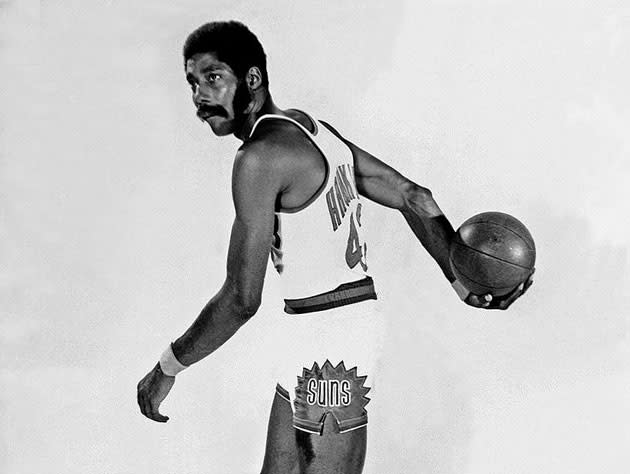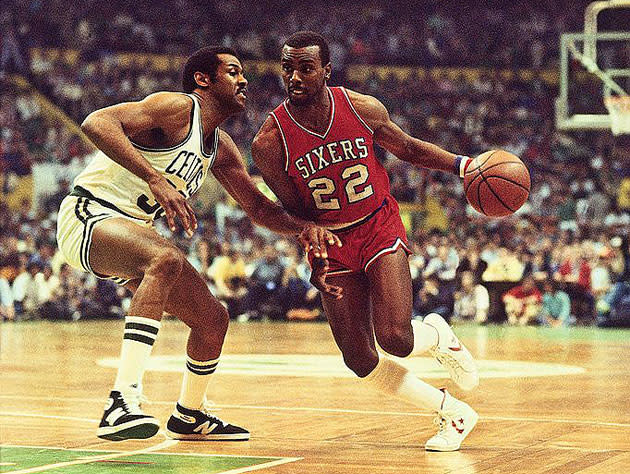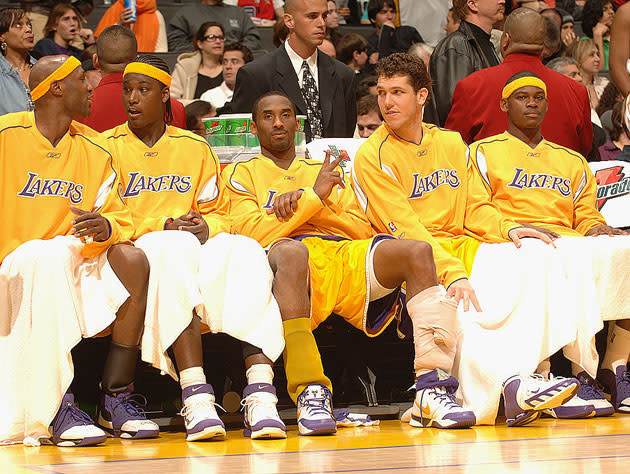BDL 25: How will the Warriors recover from a historic Finals collapse?

The NBA offseason has brought many changes to rosters, coaching staffs, and the list of championship contenders. As we draw closer to opening night, it’s time to move our focus from the potential impact of each offseason event and onto the broader issues that figure to define this season. The BDL 25 takes stock of, uh, 25 key storylines to get you up to speed on where the most fascinating teams, players, and people stand on the brink of 2016-17.
Usually when you snatch defeat from the jaws of victory, you’re rewarded with a trip to Doursville, man. A chance to rue what could have been, to internally revisit the plays (after plays after plays) that could have made a difference, the things that could have gotten in the way.
[Follow Dunks Don’t Lie on Tumblr: The best slams from all of basketball]
Anything, anything that could have prevented a three-game losing streak at the worst possible time and a shocking 2016 NBA Finals loss.
You’ll recall that the Golden State Warriors, after a regular season that saw them win 73 out of 82 games, totally blew the NBA championship last June. The team went up on the Cleveland Cavaliers 3-1 to start the Finals, then didn’t win again for the final eight days of the 2015-16 NBA season.
The Cavs took the championship and the Warriors, we presume, took to the bottle. For a whole 14 days, at least, until the team was rewarded Kevin Durant for its pain.
Some parachute. An anti-sadness salve in the form of a former MVP and scoring champ working in his prime.
Still, that hasn’t stopped a mini-meme of sorts from hitting its stride during the dull days of the NBA offseason. Once the cigars ashed and the league’s free agent bonanza waned a bit, those that were too caught up in the mid-June maelstrom to give it the slowed attention it deserved seemed to realize en masse that, holy crap, Golden State had a 3-1 lead in the NBA Finals and totally let it rot.
As a result, Twitter took hold. And, as is sometimes the case, tangible results introduced themselves to our screens.
Like the work of one Conrad Kaczmarek, a Cavaliers fan living in Los Angeles, who went a little out of his way to let Californians know exactly what they missed out on:
purchased pic.twitter.com/scoGBlLrZg
— Conrad Kaczmarek (@ConradKaz) September 12, 2016
it's gonna be really great because it'll say 3 1 LEAD and be surrounded by this pic.twitter.com/iLwQxpk1YT
— Conrad Kaczmarek (@ConradKaz) September 12, 2016
Though Kaczmarek lives in California, this is a very Midwestern reaction to what should be a celebration of Cleveland’s triumph. Yes, there’s the Cavs’ plate-holder in place, but making another team’s misfortune the fulcrum of the joke is a very Ohio (as someone who briefly lived there) thing to do.
What is less certain, even with Kevin Durant in place, is what the Warriors are left to do.
Yes, the team was able to bring Durant’s talents – at 28.2 points, 8.2 rebounds and five assists per game last season – on board. Stephen Curry, Klay Thompson and Draymond Green are all a year older and, presumably, better. Andre Iguodala should hold serve while David West and Zaza Pachulia seem like veteran additions culled straight from central casting.
The team lost Andrew Bogut during the offseason, though. And even if Bogut is befallen yet again by the injury bug in 2016-17 (he now plays in Dallas), the team will at least miss the championship and near-championship work he gave the team during its two Finals runs, if not his 2017 production. Harrison Barnes worked through a fitful time as a starter on the champs’ roster, but he’ll be missed in spots, as will the just-as-fitful Marreese Speights and Festus Ezeli.
Then there is the Durant question.
The 2014 NBA MVP isn’t exactly an offensive-only marvel, but the Warriors weren’t exactly hurting for smooth scorers in 2015-16. The team with the league’s best offense and two-time MVP in Stephen Curry, in a lot of ways, would have preferred to find the next, younger installments of Andre Iguodala, Bogut and Shawn Livingston.
With those hypothetical players not on the market, the team settled for, perhaps, the best player in the NBA. Still, there is no guarantee that Durant will ease into life alongside Curry, Thompson and Green, with the fear that the chemistry may take a while to develop. LeBron James needed nearly two whole seasons to figure it out with his Miami Heat and Cleveland Cavaliers, while All-Star teams and Team USA rotations never really seem to be playing at a level that is greater or even approximating the sum gifts of its parts.
Boo-hoo.
Still, there is the deadening 3-1 deficit to comprehend, a rough mark to behold even though Cleveland’s turnaround came just days after the Warriors themselves topped Durant’s Oklahoma City Thunder in seven games following OKC’s 3-1 start to the series.
Do we have much precedence for this? Not really. The Cavs were the first team to return from a 3-1 deficit to win it all in the Finals, though there have been nine other teams that dropped three straight to end a season after a 3-1 start to a playoff series.
How did each of those license plate-makers respond?

1968-69 Philadelphia 76ers
The champion Sixers went up 3-1 on the Boston Celtics in the 1968 Eastern finals before blowing its lead, and it responded with a bit of a blowup itself. Coach Alex Hannum, after once remarking that the multicolored ABA ball belonged “on the nose of a seal,” left to coach the league’s Oakland Oaks (and win a championship in his first year). General manager Jack Ramsay took over as coach and, fearing a jump from Wilt Chamberlain to the rival league, dealt him to the Los Angeles Lakers for Darrall Imhoff, Archie Clark and Jerry Chambers.
It wasn’t nearly enough in return – what could be? – and Wilt’s replacement Lucious Jackson missed 57 games in 1968-69 due to injury. Imhoff had to take on too big a load in the pivot, and though the triptych of Chet Walker, Hal Greer and Billy Cunningham kept the team amongst the East’s elite, it fell 4-1 to the same Celtics in the first round.

1970-71 Phoenix Suns
The Connie Hawkins-led Suns nearly upset Wilt’s Lakers during the 1970 Western “semis” (the first round back then), before order set in for the Jerry Colangelo-coached club. Looking to improve its interior play a year after just missing out on the chance to draft Kareem Abdul-Jabbar No. 1 overall, the team dealt 20-point, seven-assist man Gail Goodrich to the same Lakers for center Mel Counts.
Counts was serviceable with Phoenix, averaging 11 points and six rebounds, one of six (Clem Haskins, Paul Silas, Abdul-Jabbar consolation pick Neal Walk, Hawkins, Dick Van Arsdale) Suns to average double-figure points that year. Though Phoenix won 48 games and finished tied with the Lakers for the third-best record in the West, the NBA picked the top two teams from each division to make the playoffs then. The Suns, working in the “Midwest,” had to sit out as the Pacific-bred 41-win San Francisco Warriors worked in the postseason that year.
Could be worse. The Western Conference’s Detroit Pistons, who would have finished with the third-best record had they played in the East, finished with 45 wins and missed the playoffs that season.

1979-80 San Antonio Spurs
The Eastern Conference’s San Antonio Spurs fell to the Washington Bullets in the Eastern finals in 1979 before the defending champion Bullets moved on to that year’s Finals. No major personnel shifts shaped next year’s Spurs outfit, not unlike this season’s model, but that didn’t stop the George Gervin-paced outfit from playing .500 ball throughout the year (costing Doug Moe, at 33-33 to start the season, his job) before bowing out in the first round against Houston.

1981-82 Philadelphia 76ers
The Sixers were already far, far too deep into their series of “wait ‘til next year!”-promises when they blew a 3-1 lead against Larry Bird’s Boston Celtics in the 1981 Eastern finals. Those Celtics went on to win the championship, while the Sixers steeled themselves for yet another year of trying to get over the top with its Julius Erving-led outfit. The team would go on to beat the C’s in this year’s Eastern finals, led by Andrew Toney’s 22 points per game in the series.
However, in the team’s first Finals since its 1977 loss to Portland, the Sixers fell in the face of Magic Johnson’s Los Angeles Lakers for the second time in three seasons. They would have to exact revenge (wait for it) next year in winning the championship over the Lakers.

1995-96 Phoenix Suns
The Suns, as NBA TV replays remind us every summer, blew a 3-1 lead against the eventual champion Houston Rockets in the second round of the Western playoffs in 1995; while Charles Barkley’s aching back “limited” him to just 22.3 points, 13.3 rebounds, 3.1 assists and a steal in 38 minutes a game. In the offseason the team attempted to fortify its interior reserves (after Hakeem Olajuwon averaged a ridiculous 29.6 points, nine rebounds, 3.7 assists and 3.2 combined steals/blocks against Suns in the comeback win) by dealing Dan Majerle to Cleveland for center John “Hot Rod” Williams.
The team struggled to get it all together, starting 14-19 before coach Paul Westphal was fired. Cotton Fitzsimmons took over to lead the team to the playoffs with a 41-41 record, where they lost to the San Antonio Spurs in the first round. Barkley was dealt to Houston during the 1996 offseason.

1997-98 New York Knicks
The Knicks were working their way through an expected road loss while up 3-1 to the similarly-stout Miami Heat in the 1997 Eastern semis when both teams engaged in a small skirmish that would lead to the NBA suspending several Knicks for the upcoming Games 6 and 7. Miami took the series, and the smarting Knicks responded by keeping its core intact for the next season, thinking (not unfairly) itself the better team.
Just two months into that campaign, though, Patrick Ewing fell on and destroyed the right wrist in his shooting hand after Andrew Lang fouled him while in midair. The 35-year old was still averaging nearly 21 points, 11 rebounds and over two blocks per game in just 32 minutes a night, and New York’s season was effectively over following the injury – the team would go on to lose in the second round.
The summer following the 3-1 fall also did little to dissuade the Knicks from its fighting instincts. Forward Larry Johnson and, infamously, coach Jeff Van Gundy took part in a Game 4 brawl against the Heat in the first round of the 1998 playoffs, this time costing Miami its best chance at a championship during the Alonzo Mourning era.

2003-04 Orlando Magic
Tracy McGrady went off in the first four games of his team’s opening round series against Detroit in 2003, averaging 36.2 points per game (despite a miserable supporting cast) as the Magic took hold of a 3-1 lead against one of the NBA’s best defenses. Infamously, McGrady mistakenly told reporters that “it feels good to get to the second round” in the minutes following his team’s third win of the series, with the NBA in its first year of making the opening round series a best-of seven, rather than a best-of five. With one more game to win, Orlando took the collar.
The next season started with Orlando winning its first game of the season in overtime against New York, prior to losing 19 straight. That malaise cost coach Doc Rivers his job after a 1-10 start, as the team went on to field a 21-win record. The team’s personnel chief John Weisbrod – who never had a basketball gig prior to a brief administrative stint with the Magic and hasn’t had a basketball job in the years since leaving the team in 2005 – dealt McGrady for Steve Francis and Cuttino Mobley (later dealt for an aging Doug Christie) the following offseason.

2006-07 Los Angeles Lakers
The Lakers, led by Kobe Bryant’s most prolific year, roared back into the postseason and nearly upset the No. 2 seeded Phoenix Suns in the first round of the playoffs before losing three straight to end its campaign. That Game 7 was marked from an oddly (purposefully?) passive turn from Kobe, and the team did little to improve its capped-out prospects in the offseason that followed. As a result, the Lakers turned in a 41-win year that featured 80 starts from Smush Parker before bowing out in the first round against the Suns – this time by a 4-1 margin.

2015-16 Los Angeles Clippers
In a sense, the way that last season’s Clippers kept it all together was rather masterful. The team featured Blake Griffin and DeAndre Jordan in their primes, J.J. Redick’s best season thus far and Chris Paul offering his usual contributions, but it could have fallen hard following its Western semis loss to the Rockets in 2015. The team rebounded from Houston’s return in the face of a 3-1 deficit to win 53 games in the loaded West despite a laughingly bad set of rotation pieces beyond the stars, and Griffin’s 47 games missed due to injury and suspension for assaulting a member of the team’s training staff.
By the time the playoffs hit, though, the juice was all out. The Clippers, considered a championship hopeful heading into the year, bowed out in the first round against Portland.
Do these Warriors have a chance to avenge the fortunes of those who came before them, and grab the title in 2017?
(Well, yeah. They got Kevin Durant.)
Previously, on BDL 25:
Chris Bosh’s increasingly hazy career prospects
Kevin Durant sets about winning back our love
Stephen Curry’s search for an encore, and for invincibility lost
The NBA, social activism and a change we need to see in 2016-17
The Trail Blazers, and the promise and peril of ‘pretty good’
Will the Pistons ever get into gear?
Introducing the (maybe) thoroughly modern Grizzlies
Is the new-look Indiana Pacers’ core worth fearing?
It’s time for Anthony Davis to resume blowing our minds
More NBA coverage from Yahoo Sports:
– – – – – – –
Kelly Dwyer is an editor for Ball Don’t Lie on Yahoo Sports. Have a tip? Email him at KDonhoops@yahoo.com or follow him on Twitter!

